
(a)
Interpretation:
For the given proposed transforms, it is to be determined whether it leads to a synthetic trap (i.e. will not proceed as planned in the forward direction) or not along with the reasoning.
Concept introduction:
A particular reaction is undone by performing a transform that depends on the specific location in the target molecule where we want the changes to occur. In doing so, we may encounter synthetic traps. A synthetic trap is the proposed mechanism that prevents the reaction to occur in the forward direction as planned. From the reactions used for
Answer to Problem 13.6P
The synthesis will proceed as planned. The forward reaction is shown below:
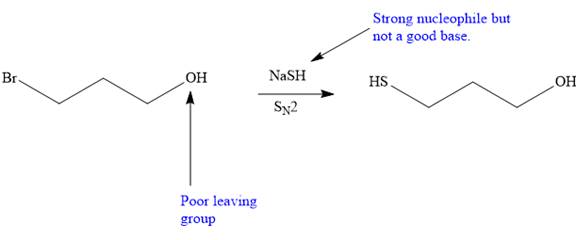
Explanation of Solution
The given proposed transform is:

The target molecule is on the left side. In the target molecule, there are two functional groups present, a cyanide and hydroxyl group. In order to carry out this transform, sodium cyanide (

Thus, the proposed transform does not lead to a synthetic trap and will proceed as planned.
The possibility of the forward reaction in the proposed mechanism is determined on the basis of the functional group transformation reactions, charge stability, and strength of the reagents used.
(b)
Interpretation:
For the given proposed transforms, it is to be determined whether it leads to a synthetic trap (i.e. will not proceed as planned in the forward direction) or not along with the reasoning.
Concept introduction:
A particular reaction is undone by performing a transform that depends on the specific location in the target molecule where we want the changes to occur. In doing so, we may encounter synthetic traps. A synthetic trap is the proposed mechanism that prevents the reaction to occur in the forward direction as planned. From the reactions used for functional group transformation and considering the factors like charge stability and strength of the reagent used, one can determine whether the proposed transform leads to a synthetic trap or not.
Answer to Problem 13.6P
The synthesis will proceed as planned. The forward reaction is shown below:
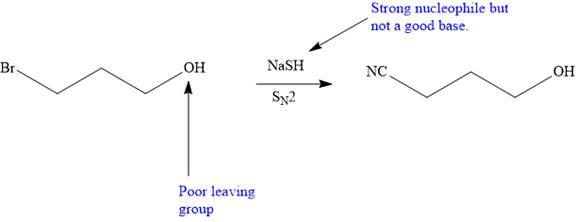
Explanation of Solution
The given proposed transform is:
![]()
The target molecule is on the left side. In the target molecule, there are two functional groups present,
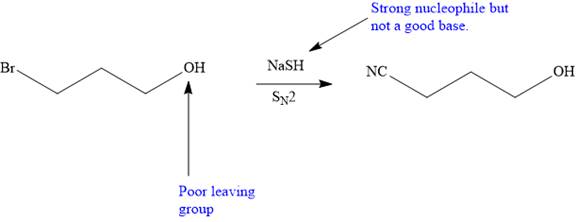
Thus, the proposed transform does not lead to a synthetic trap and will proceed as planned.
The possibility of the forward reaction in the proposed mechanism is determined on the basis of the functional group transformation reactions, charge stability, and strength of the reagents used.
(c)
Interpretation:
For the given proposed transforms, it is to be determined whether it leads to a synthetic trap (i.e. will not proceed as planned in the forward direction) or not along with the reasoning.
Concept introduction:
A particular reaction is undone by performing a transform that depends on the specific location in the target molecule where we want the changes to occur. In doing so, we may encounter synthetic traps. A synthetic trap is the proposed mechanism that prevents the reaction to occur in the forward direction as planned. From the reactions used for functional group transformation, and considering the factors like charge stability and strength of the reagent used, one can determine whether the proposed transform leads to a synthetic trap or not.
Answer to Problem 13.6P
The synthesis will proceed as planned. The forward reaction is shown below:
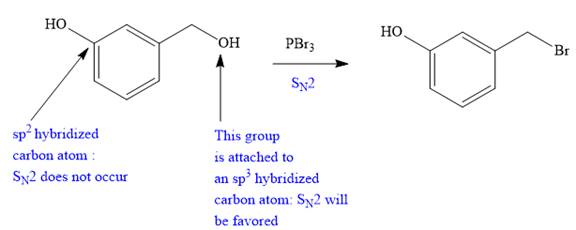
Explanation of Solution
The given proposed transform is:

The target molecule is on the left side. In the target molecule, there are two functional groups present, alkyl halide and hydroxyl group.

Thus, the proposed transform does not lead to a synthetic trap and will proceed as planned.
The possibility of the forward reaction in the proposed mechanism is determined on the basis of the functional group transformation reactions, charge stability, and strength of the reagents used.
(d)
Interpretation:
For the given proposed transforms, it is to be determined whether it leads to a synthetic trap (i.e. will not proceed as planned in the forward direction) or not along with the reasoning.
Concept introduction:
A particular reaction is undone by performing a transform that depends on the specific location in the target molecule where we want the changes to occur. In doing so, we may encounter synthetic traps. A synthetic trap is the proposed mechanism that prevents the reaction to occur in the forward direction as planned. From the reactions used for functional group transformation, and considering the factors like charge stability and strength of the reagent used, one can determine whether the proposed transform leads to the synthetic trap or not.
Answer to Problem 13.6P
The synthesis will not proceed as planned.
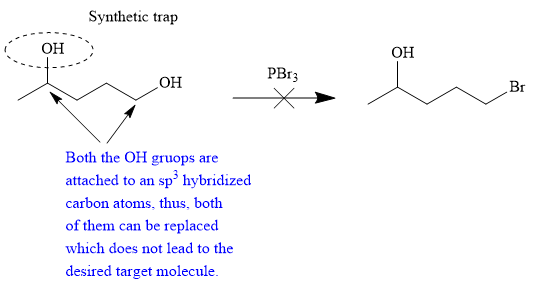
The proposed synthesis is a synthetic trap, and the reaction will not proceed as planned in the forward direction.
Explanation of Solution
The given proposed transform is:

The target molecule is on the left side while the proposed reactant molecule is on the right side. In the target molecule, there are two functional groups present, alcohol and alkyl halide. Alkyl halides are prepared from corresponding alcohols when they are treated with phosphorous bromide/chloride in an

The possibility of the forward reaction in the proposed mechanism is determined on the basis of the functional group transformation reactions, charge stability, and strength of the reagents used.
(e)
Interpretation:
For the given proposed transforms, it is to be determined whether it leads to a synthetic trap (i.e. will not proceed as planned in the forward direction) or not along with the reasoning.
Concept introduction:
A particular reaction is undone by performing a transform that depends on the specific location in the target molecule where we want the changes to occur. In doing so, we may encounter synthetic traps. A synthetic trap is the proposed mechanism that prevents the reaction to occur in the forward direction as planned. From the reactions used for functional group transformation, and considering the factors like charge stability and strength of the reagent used, one can determine whether the proposed transform leads to the synthetic trap or not.
Answer to Problem 13.6P
The synthesis will not proceed as planned.

The proposed synthesis is a synthetic trap, and the reaction will not proceed as planned in the forward direction.
Explanation of Solution
The given proposed transform is:
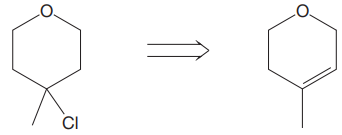
The target molecule is on the left side while the proposed reactant molecule is on the right side. In the target molecule, there are two functional groups present, ether and alkyl halide. Alkyl halides are prepared from
As the reaction does not yield the desired product, we would say that the proposed synthesis is a synthetic trap, and the reaction will not proceed as planned in the forward direction.

The possibility of the forward reaction in the proposed mechanism is determined on the basis of the functional group transformation reactions, charge stability, and strength of the reagents used.
(f)
Interpretation:
For the given proposed transforms it is to be determined whether it leads to a synthetic trap (i.e. will not proceed as planned in the forward direction) or not along with the reasoning.
Concept introduction:
A particular reaction is undone by performing a transform that depends on the specific location in the target molecule where we want the changes to occur. In doing so, we may encounter synthetic traps. A synthetic trap is the proposed mechanism that prevents the reaction to occur in the forward direction as planned. From the reactions used for functional group transformation, and considering the factors like charge stability and strength of the reagent used, one can determine whether the proposed transform leads to the synthetic trap or not.
Answer to Problem 13.6P
The synthesis will not proceed as planned.

The proposed synthesis is a synthetic trap, and the reaction will not proceed as planned in the forward direction.
Explanation of Solution
The given proposed transform is:

The target molecule is on the left side while the proposed reactant molecule is on the right side. In the target molecule, there are two functional groups present,
As the reaction does not yield the desired product, we would say that, the proposed synthesis is a synthetic trap and the reaction will not proceed as planned in the forward direction.

The possibility of the forward reaction in the proposed mechanism is determined on the basis of the functional group transformation reactions, charge stability, and strength of the reagents used.
Want to see more full solutions like this?
Chapter 13 Solutions
EBK GET READY FOR ORGANIC CHEMISTRY
- Nonearrow_forwardNonearrow_forwardn Feb 3 A T + 4. (2 pts) Draw the structure of the major component of the Limonene isolated. Explain how you confirmed the structure. 5. (2 pts) Draw the fragment corresponding to the base peak in the Mass spectrum of Limonene. 6. (1 pts) Predict the 1H NMR spectral data of R-Limonene. Proton NMR: 5.3 pon multiplet (H Ringarrow_forward
- Part VI. Ca H 10 O is the molecular formula of compound Tom and gives the in the table below. Give a possible structure for compound Tom. 13C Signals summarized C1 C2 C3 C4 C5 C6 C7 13C shift (ppm) 23.5 27.0 33.0 35.8 127 162 205 DEPT-90 + DEPT-135 + +arrow_forward2. Using the following data to calculate the value of AvapH o of water at 298K. AvapH o of water at 373K is 40.7 kJ/mol; molar heat capacity of liquid water at constant pressure is 75.2J mol-1 K-1 and molar heat capacity of water vapor at constant pressure is 33.6 J mol-1 K-1.arrow_forwardPart VII. Below are the 'HNMR 13 3 C-NMR, COSY 2D- NMR, and HSQC 20-NMR (Similar with HETCOR but axes are reversed) spectra of an organic compound with molecular formula C6H13 O. Assign chemical shift values to the H and c atoms of the compound. Find the structure. Show complete solutions. Predicted 1H NMR Spectrum ли 4.7 4.6 4.5 4.4 4.3 4.2 4.1 4.0 3.9 3.8 3.7 3.6 3.5 3.4 3.3 3.2 3.1 3.0 2.9 2.8 2.7 2.6 2.5 2.4 2.3 2.2 2.1 2.0 1.9 1.8 1.7 1.6 1.5 1.4 1.3 1.2 1.1 1.0 0.9 0.8 f1 (ppm)arrow_forward
- 3. Draw the expanded structural formula, the condensed structural formula, and the skeletal structural formula for 2-pentene. expanded structure: Condensed structure: Skeletal formula: 4. Draw the expanded structural formula, the condensed structural formula, and the skeletal structural formula for 2-methyl-3-heptene. expanded structure: Condensed structure: Skeletal formula: following structurearrow_forwardPart IV. Propose a plausible Structure w/ the following descriptions: a) A 5-carbon hydrocarbon w/ a single peak in its proton decoupled the DEPT-135 Spectrum shows a negative peak C-NMR spectrum where b) what cyclohexane dione isomer gives the largest no. Of 13C NMR signals? c) C5H120 (5-carbon alcohol) w/ most deshielded carbon absent in any of its DEPT Spectivaarrow_forward13C NMR is good for: a) determining the molecular weight of the compound b) identifying certain functional groups. c) determining the carbon skeleton, for example methyl vs ethyl vs propyl groups d) determining how many different kinds of carbon are in the moleculearrow_forward
- 6 D 2. (1 pt) Limonene can be isolated by performing steam distillation of orange peel. Could you have performed this experiment using hexane instead of water? Explain. 3. (2 pts) Using GCMS results, analyze and discuss the purity of the Limonene obtained from the steam distillation of orange peel.arrow_forwardPart III. Arrange the following carbons (in blue) in order of increasing chemical shift. HO B NH 2 A CIarrow_forward6. Choose the compound that will produce the spectrum below and assign the signals as carbonyl, aryl, or alkyl. 100 ō (ppm) 50 0 7. 200 150 Assign all of the protons on the spectrum below. 8. A B 4 E C 3 ō (ppm) 2 1 0 Choose the compound that will produce the spectrum below and assign the signals to the corresponding protons. OH 6 OH 3 2 1 0 4 ō (ppm)arrow_forward
 Organic Chemistry: A Guided InquiryChemistryISBN:9780618974122Author:Andrei StraumanisPublisher:Cengage Learning
Organic Chemistry: A Guided InquiryChemistryISBN:9780618974122Author:Andrei StraumanisPublisher:Cengage Learning
